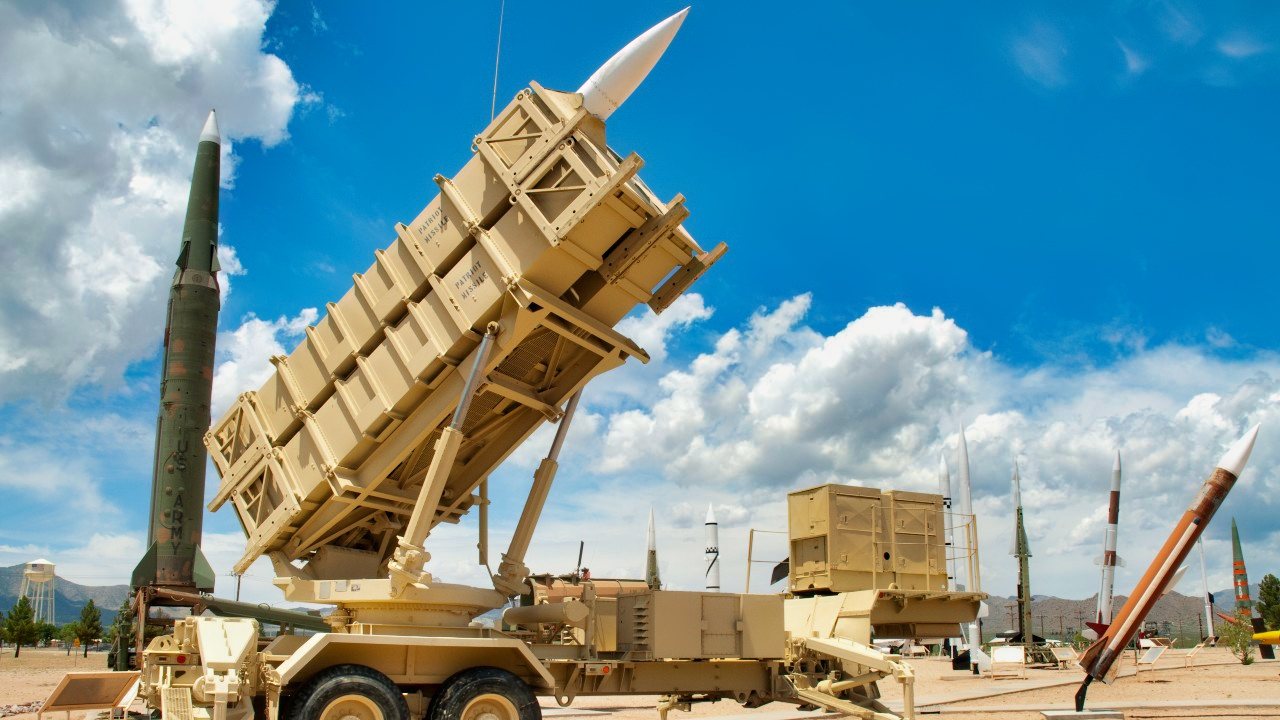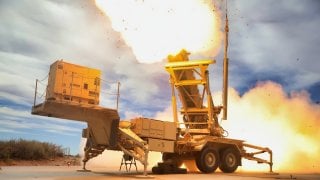The U.S. Navy Could Soon Get Patriot Missiles
The U.S. Navy is experimenting with deploying Army Patriot Advanced Capability-3 Missile Segment Enhancement (PAC-3 MSE) surface-to-air missiles aboard surface combatants fitted with the Mk 41 vertical launch system (VLS), in effect, a block of siloes embedded in a warship’s main deck.
Last week Reuters broke newish news on a development years in the making. Namely, the U.S. Navy is experimenting with deploying Army Patriot Advanced Capability-3 Missile Segment Enhancement (PAC-3 MSE) surface-to-air missiles aboard surface combatants fitted with the Mk 41 vertical launch system (VLS), in effect a block of siloes embedded in a warship’s main deck. As Ticonderoga-class cruisers go to their reward after long service lives, that mainly means Arleigh Burke-class destroyers may sport PAC-3 MSE interceptors in coming years.
The venture awaits at-sea testing following successful shore testing last May. Mating the missile up with the Aegis combat system seems to have been the chief impediment. Aegis, long the state of the art in fleet air and missile defense, is an integrated phased-array radar, computer, and fire-control system that helps crews manage their combat surroundings. Aegis ships’ SPY-1 radars communicate in one frequency band, Patriot interceptors another. Weaponeers reportedly surmounted that impediment by modifying the missile’s communication uplink to accommodate signals from Aegis.
This is a good-news story all around. Über-agile Patriots have a proven battle record, having shot down maneuvering Russian hypersonic missiles over Ukraine. This new supplement to surface fleets’ layered air defenses could fortify deterrence in increasingly contested expanses such as the Western Pacific. Xi Jinping might think twice about, say, ordering a cross-strait invasion of Taiwan if he feared U.S. Navy task forces would ride out People’s Liberation Army (PLA) missile barrages, gather near the scene of battle, and sink the invasion fleet short of the beaches. China’s dream of national rejuvenation would founder with it.
Fear is a doughty ally in efforts to deter.
Substituting PAC-3s for interceptors already in the U.S. Navy inventory would bolster the fleet’s offensive striking power as well. Not because of affordability. A PAC-3 MSE costs about the same as a Navy SM-6 interceptor, at just north of $4 million per round. But the versatile SM-6 boasts an anti-ship capability to go along with its anti-air function. That allows U.S. warships to lash out at rival fleets from long distances. This is an invaluable interim solution to a nettlesome problem—namely that PLA Navy missiles long outranged those found in American launchers. A rangier combatant enjoys the option to pound away at a distance before its opponent can return fire. The SM-6 should tide the surface navy over until such ordnance as purpose-built Long-Range Anti-Ship Missiles and Maritime Strike Tomahawks can be built and fielded in bulk.
Every SM-6 not needed for defense is an SM-6 available for offense.
But this is a good-news story in a larger sense. This is an age of joint sea power. It only makes sense that sea and land-based services would ransack one another’s armories for useful kit, such as Patriots and the Mk 41 VLS. And it’s not just the U.S. Navy making use of Army weaponry. The Army is now able to fire Navy SM-6s and Tomahawks at ships from its Typhon Strategic Mid-Range Fires System, having dispatched a Typhon battery to the Philippines last spring.
Reciprocity is a fine thing. Long may collaborative projects continue.

The Reuters story points to a weird dichotomy in U.S. Navy fleet development. Former chief of naval operations Jonathan Greenert was fond of distinguishing between platforms and payloads. Admiral Greenert exhorted the Navy to put its emphasis on the latter. Rather than incorporate sensors, weapons, unmanned systems, and other hardware intimately into a ship’s structure—making it time-consuming, labor-intensive, and pricey to rip out old gear and replace it with new across a platform’s long service life—shipwrights should take a modular approach to ship design. Much as a USB port makes it easy to change out hardware and software on your computer, plug-and-play naval equipment would simplify upgrades. In turn the fleet could more readily reinvent itself to keep pace with surroundings in flux.
And in statecraft, keeping abreast of changing times and circumstances is what it’s all about.
Now, the U.S. Navy is a dumpster fire when it comes to acquiring new platforms. This is well documented. Fleet numbers are on the wane at the moment as old vessels retire faster than new ones replace them. Shipbuilding programs are uniformly behind schedule and commonly over budget. The maritime industry is in a dismal state, making it hard to arrest woeful trendlines. At the same time, though, the Navy is faring reasonably well by Greenert’s standard. The sea service is fielding new payloads, repurposing existing ones, and borrowing from other services. Whether novel payloads toted by a stagnant number of platforms are enough to deliver competitive success against the likes of China and Russia remains to be seen.
But they’re the best option on the table.

About the Author: Dr. James Holmes, U.S. Naval War College
Dr. James Holmes is J. C. Wylie Chair of Maritime Strategy at the Naval War College and a Distinguished Fellow at the Brute Krulak Center for Innovation & Future Warfare, Marine Corps University. The views voiced here are his alone.
Image Credit: Creative Commons and/or Shutterstock.

